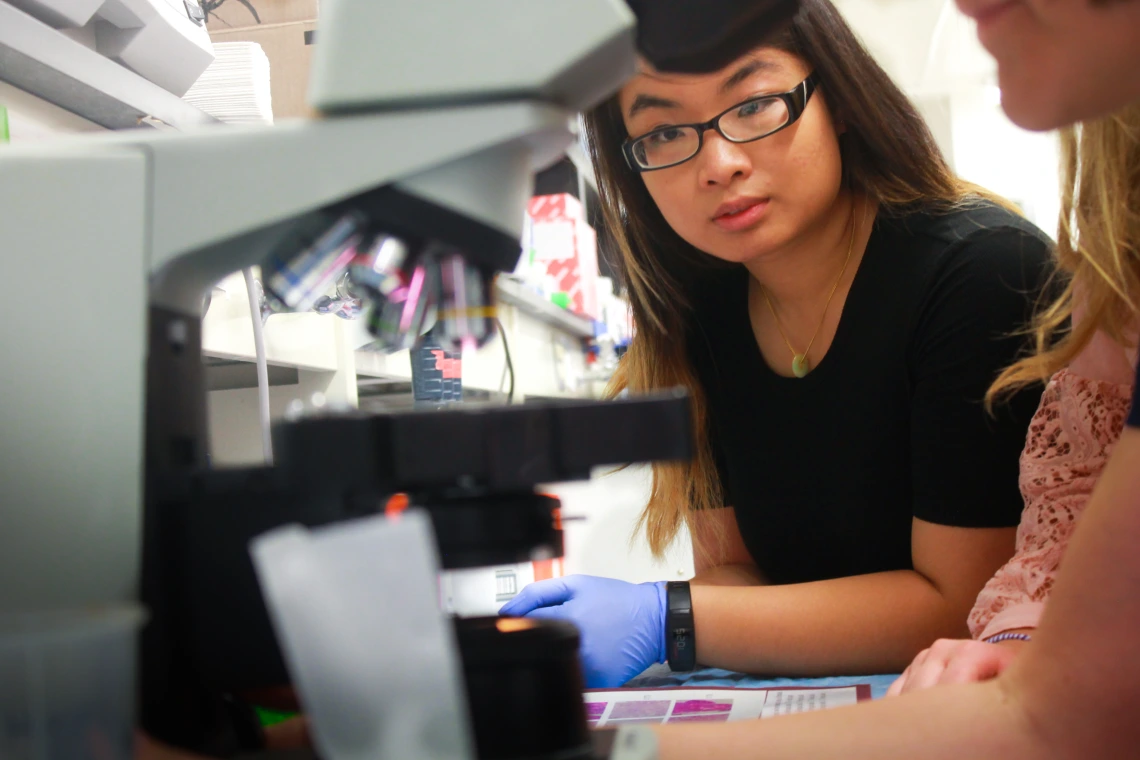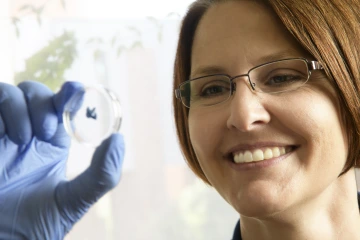UA Cancer Biology Graduate Student Travels ‘ROCKy’ Road Toward a Cure for Post-Radiation Dry Mouth
The Limesand Lab at the University of Arizona is devoted to improving quality of life for head-and-neck cancer survivors, who often suffer from irreversible dry mouth.

The Limesand Lab at the University of Arizona is devoted to improving quality of life for head-and-neck cancer survivors, who often suffer from irreversible dry mouth.
The United States is in the midst of a head-and-neck cancer epidemic. Although survival rates are relatively high — after treatment with chemotherapy and radiation — survivors can suffer permanent loss of salivary function, potentially leading to decades of health problems and difficulties eating.
It is unknown why the salivary gland sometimes cannot heal after radiation damage, but Wen Yu “Amy” Wong, BS, a University of Arizona cancer biology graduate student, may have taken a step toward solving that riddle.
Permanent dry mouth
Head-and-neck cancer — which can strike anywhere from the lips to the larynx, and up into the sinuses and nasal cavity — is typically treated with chemotherapy and radiation, which often comes with long-term or even permanent side effects. With a head-and-neck tumor in radiation’s crosshairs, the salivary gland might suffer collateral damage.
“When you get radiation therapy, you end up targeting your salivary glands as well,” Wong said. “These patients often lose their ability to salivate, predisposing them to oral complications and an overall decrease in their quality of life.”
In that case, the benefits of saliva that might have been taken for granted disappear.
“Salivary glands help you digest food, lubricate your mouth and fight against bacteria,” said Wong. “After radiation, patients could choke on their food because they can’t swallow. They wake up in the middle of the night because their mouth is so dry. They often get cavities.”
“If I have a mouth full of canker sores and I have to go to the dentist all the time so I don’t lose my teeth, life is pretty miserable,” added senior author Kirsten Limesand, PhD, of the University of Arizona Cancer Center and professor of nutritional sciences with the UA College of Agriculture and Life Sciences.
Quality of life is further compromised when favorite foods lose their flavor.
“Saliva produces certain ions that help you taste,” Wong said. “Patients lose the ability to enjoy food. The best steak is very bland to them.”
Patients rely on options that treat their symptoms but don’t offer a cure.
“They’re given saliva stimulants such as gum,” says Wong. “But if the salivary cells themselves are already damaged, it’s hard to stimulate them. Hopefully we can find a better treatment that can fully restore salivary function instead of relieving the side effects of radiation damage.”
‘ROCKy’ road
To improve survivors’ health and quality of life, scientists need to find a way to restore salivary function in post-radiation head-and-neck cancer patients. This quest starts with learning why the salivary gland is unable to heal itself after radiation damage.
Wong’s study may have helped to unravel this mystery. Her team looked closely at two proteins, E-cadherin and β-catenin, which allow communication between cells. Normally, these proteins bind cells together, but after radiation damage, these connections are severed. “Think of them as telephone wires,” Wong said. “Radiation is like lightening hitting a telephone pole. That breaks the ability of one friend to talk to another on the other side of the city.”
Just as a maintenance crew can repair downed telephone poles after a storm, the body is able to heal itself after injury. Unfortunately, in post-radiation dry mouth, salivary glands’ ability to regenerate might be blocked.
In the lab, Wong was able to artificially force the regeneration of salivary glands, allowing her to learn where there are obstructions in the regeneration process. Wong particularly was interested in something called the ROCK pathway, which might go awry in the wake of radiation, blocking E-cadherin and β-catenin from reuniting.
“If I use an inhibitor to prevent this ROCK signaling pathway, these two proteins come back together,” Wong said.
The next step is to learn more about how a defective ROCK pathway blocks salivary glands’ natural ability to regenerate following radiation damage. Unlocking this secret could uncover novel ways to treat or cure post-radiation dry mouth.
Mentoring the next generation of scientists
201800377-limesand_lab_0221_-_edited.jpgKirsten Limesand, PhD (credit: Kris Hanning, UAHS BioCommunications)
Earlier this month, Wong and her co-authors were recognized by the American Physiological

Society for their investigation, which was published in June by the American Journal of Physiology – Regulatory, Integrative and Comparative Physiology. Wong and Dr. Limesand, along with Maricela Pier, BS, a research specialist with the UA College of Medicine – Tucson Department of Cellular and Molecular Medicine, were selected for the APSselect award, given to the best articles in physiological research.
Wong did rotations through several laboratories before selecting Dr. Limesand’s lab as her “home base” throughout her graduate studies.
“I wanted to connect with a woman in science who understands the difficulties,” said Wong. “She was very easy to talk to, and the people in the lab provide a very nurturing environment. I just knew that was the place for me. She is a great mentor.”
Dr. Limesand takes her role as a mentor seriously, and finds it deeply satisfying.
“Hands down, the most rewarding aspect of my career is training students,” Dr. Limesand said. “They’re our next generation of scientists, tackling the big questions that need to be solved.”
Dr. Limesand is a professor with the UA Cancer Biology Graduate Interdisciplinary Program, which emphasizes translational research to address significant problems relating to cancer development and treatment. Students are prepared for careers in cancer research through an interdisciplinary approach involving faculty members from a wide range of disciplines.
“I am in the Nutritional Sciences Department, but I have students from cancer biology and physiological sciences, I’ve been on committees of genetics students and immunobiology students, so you have all these diverse perspectives,” said Dr. Limesand. “At the end of the day, these perspectives add to the research we’re doing.”
This research was supported in part by NIH R01 DE023534 and the Cancer Biology Training Grant, T32CA009213-38.
A cancer epidemic
According to the U.S. Centers for Disease Control and Prevention, an estimated 63,030 Americans were diagnosed with head-and-neck cancer in 2017, and 13,360 people lost their lives to this disease. Historically, the most important risk factors for head-and-neck cancer consisted of alcohol use, tobacco use, poor oral hygiene and missing teeth. In recent years, however, the profile of a head-and-neck cancer patient has been changing.
Although HPV — human papillomavirus — is most noted for causing cervical cancer, currently the virus causes an increasing proportion of head-and-neck cancers. HPV-associated cancers are most likely to strike a part of the body called the oropharynx, which is the opening of the throat behind the oral cavity. Oropharyngeal cancer is four times as common in men as in women, and a study published in 2016 estimated that HPV causes 12,638 annual cases of oropharyngeal cancer among males, compared to 3,100 among females.
An HPV vaccine has been available since 2006, and the current version protects against seven cancer-causing viral strains. Today’s head-and-neck cancer epidemic underscores the need to vaccinate pre-teens and adolescents against this common virus. While the FDA has not yet approved the vaccine for prevention of head-and-neck cancer, that could change as scientists continue to collect data.
About the University of Arizona Cancer Center
The University of Arizona Cancer Center is the only National Cancer Institute-designated Comprehensive Cancer Center with headquarters in Arizona. The UArizona Cancer Center is supported by NCI Cancer Center Support Grant No. CA023074. With its primary location at the University of Arizona in Tucson, the Cancer Center has more than a dozen research and education offices throughout the state, with more than 300 physicians and scientists working together to prevent and cure cancer. For more information: cancercenter.arizona.edu (Follow us: Facebook | Twitter | YouTube).
About the UA College of Agriculture and Life Sciences
Since the founding of the University of Arizona in 1885, the College of Agriculture and Life Sciences has been deeply rooted in Arizona communities. Through research, education, collaboration and partnerships, CALS has supported the growth of local industries, contributing to the economic success of the state. Today, we continue to build upon this legacy by tackling the grand challenges of our time related to water, air, food, families and consumption of resources. The College’s 10 academic units and 34 research centers and institutes advance sustainability by investigating solutions that positively impact Arizona and arid land regions around the world.



